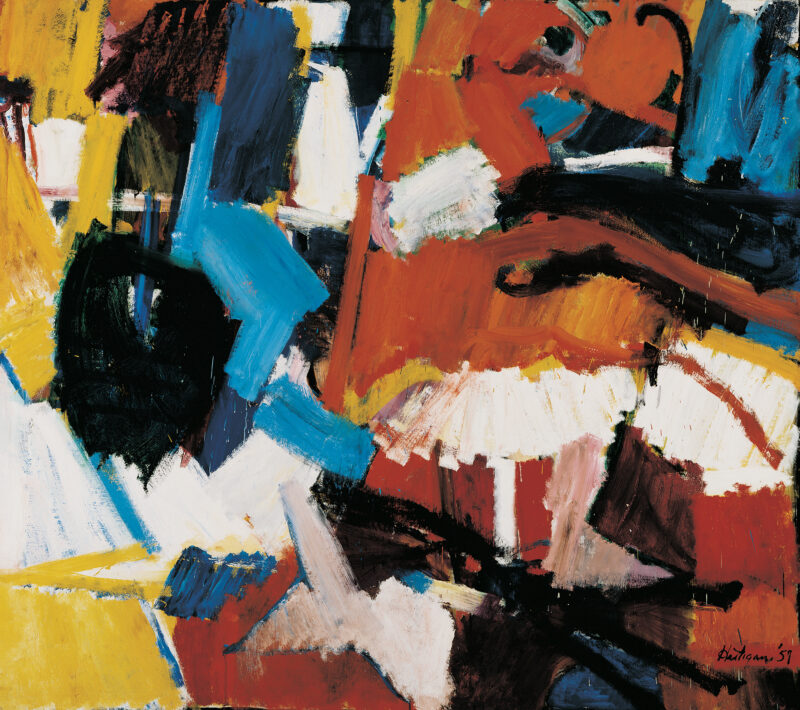
East River Drive
Hartigan, Grace
1957
Artwork Information
-
Title:
East River Drive
-
Artist:
Hartigan, Grace
-
Artist Bio:
American, 1922–2008
-
Date:
1957
-
Medium:
Oil on canvas
-
Dimensions:
70 1/4 x 79 1/4 inches
-
Credit Line:
Wichita Art Museum, Robert and Betty Foulston Fund
-
Object Number:
1989.21
-
Display:
Not Currently on Display
About the Artwork
Born in Newark, New Jersey, Grace Hartigan was raised in nearby Bayonne. She took her first drawing and painting classes soon after high school and supported herself with various jobs, including modeling for Hans Hofmann’s painting classes. Her early art was representational and influenced by the bold colors and simplified forms of Matisse. After moving to New York City in 1945, she encountered Jackson Pollock’s drip paintings, and was inspired to paint abstractions herself.
Unlike Pollock, however, Hartigan continued to refer to the environment around her, even while working in an abstract mode. “I had found that my best work had some roots in the visual world,” she later recalled. “I just had to throw in something of the life around me, even if it was just fragments, little memories . . .”1 Hartigan was attracted not only to places typically considered beautiful, such as the peaceful countryside depicted in New England, October (1957, Albright-Knox Art Gallery), but also to places and things often considered unpleasant or even ugly, such as a crowded street or a busy expressway. She stated, “Our highways are fantastic . . . most of all I like to work directly from American sources and phenomena.”2
Many of Hartigan’s paintings of the mid-fifties, including East River Drive, were inspired by her urban surroundings. While living in an old garment building in New York City’s Lower East Side from 1950-60, she absorbed the rhythms of the city from her studio window and by taking walks around the neighborhood. The paintings she created, such as Grand Street Brides (1954, Whitney Museum of American Art), City Life (1956, Nelson A. Rockefeller Collection), and East River Drive differed greatly from works by preceding artists who were inspired by the city and the Lower East Side. Whereas the early twentieth-century Ashcan School artists such as George Luks painted genre scenes focusing on the people of the Lower East Side, Hartigan painted her personal responses to the neighborhood and its constant activity.
Hartigan produced works that included fragments of the visible world and others that were completely abstract, such as East River Drive. In this painting, rather than depicting the expressway cars and street signs she saw on her walks to the East River Drive (which borders the East River and spans the east side of Manhattan), Hartigan represented her own reactions to the busy highway with energetic brushwork and bold colors. Jagged brushstrokes of bright blues, oranges, and yellows collide and bounce off each other, forming a jazz-like rhythm. Splatters of paint evoke the animated pace of the freeway and urban life. Brushy patches of white pigment abruptly interrupt the scene as would blaring car horns. In East River Drive, one can almost sense the proliferation of cars, traffic, and superhighways that increased the pace of New York City street life during the fifties.
With evident pleasure, Hartigan transformed the ordinary expressway into something extraordinary. The artist stated: “I have found my subject; it concerns that which is vulgar and vital in American modern life, and the possibilities of its transcendence into the beautiful. I do not wish to describe my subject matter or to reflect upon it—I want to distill it until I have its essence.”3
1. Grace Hartigan, quoted in Cindy Nemser, Art Talk (New York: Charles Scribners Sons, 1975), 156-57.
2. Grace Hartigan, quoted in Lee Nordness, ed., Art USA Now (New York: Viking Press, 1963), 356.
3. Grace Hartigan, quoted in Dorothy C. Miller, ed., Twelve Americans (New York: The Museum of Modern Art, 1956), 53.